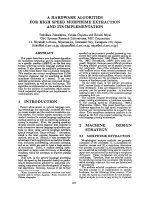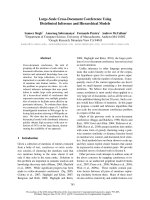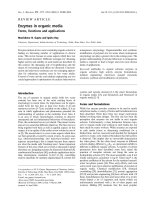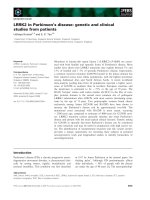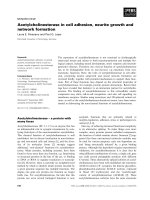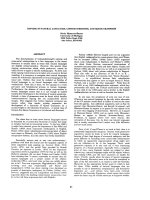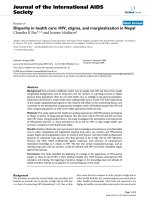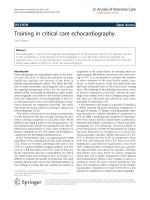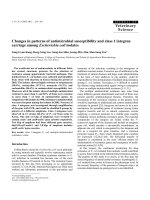Báo cáo khoa học: "Year in review in Critical Care, 2004: sepsis and multi-organ failure." pptx
Bạn đang xem bản rút gọn của tài liệu. Xem và tải ngay bản đầy đủ của tài liệu tại đây (53.16 KB, 5 trang )
409
ICU = intensive care unit; IL = interleukin; MODS = multi-organ dysfunction syndrome.
Available online />Introduction
During 2004, Critical Care published a broad range of
original research focused on sepsis and the multi-organ
dysfunction syndrome (MODS). These studies included
epidemiologic surveys, assessments of the pathogenesis of
the syndrome, analyses of prognostic variables in affected
patients, and new therapeutic modalities.
National rates of sepsis
In an attempt to determine country-specific rates of sepsis,
three studies estimated the incidence of sepsis in the
Netherlands [1], in Norway [2], and in Brazil [3].
van Gestel and colleagues [1] performed a cross-sectional
survey of patients in 47 Dutch intensive care units (ICUs)
using American College of Chest Physicians/Society of
Critical Care Medicine consensus criteria for sepsis, severe
sepsis, or septic shock [4]. The authors estimated an
incidence of severe sepsis of 0.54 cases/1000 population per
year, indicating that severe sepsis accounts for 0.61% of all
hospital admissions and for 11% of all ICU admissions in the
Netherlands.
Flaatten [2] used International Classification of Diseases
(ICD-10) codes in a national dataset in Norway to detect
episodes of sepsis. They found an incidence of sepsis of
1.49 cases/1000 population. Among hospitalized patients,
the sepsis and severe sepsis rates were 9.5 and 3.0 cases
per 1000 admissions, respectively. Incidence and mortality
rates rose in an age-dependent fashion.
Silva and colleagues [3] described the findings of the
Brazilian Sepsis Epidemiological Study, a prospective cohort
study of consecutive adult admissions to five Brazilian ICUs.
The rates of sepsis, of severe sepsis, and of septic shock
were 305, 174, and 147 cases per 1000 ICU admissions,
respectively. Approximately two-thirds of septic patients met
diagnostic criteria on admission, with the remainder
diagnosed on subsequent days. The mortality rates of
patients with the systemic inflammatory response syndrome,
sepsis, severe sepsis, and septic shock were 24.2%, 33.9%,
46.9%, and 52.2%, respectively. Survival was lower in the
septic patients compared with those patients without sepsis.
Diagnosis and transmission of infections
Controversy exists in the approach to diagnosing ventilator-
associated pneumonia. Camargo and colleagues [5]
assessed the utility of tracheal aspirates to diagnose
ventilator-associated pneumonia in mechanically ventilated
patients. Qualitative culture had the highest sensitivity in the
diagnosis of ventilator-associated pneumonia but had poor
specificity when compared with quantitative analysis. The
bacterial yield was affected by antibiotic use. Overall, the
authors concluded that quantitative assessment of tracheal
secretions is superior to qualitative measures for diagnosing
ventilator-associated pneumonia.
Agvald-Ohman and colleagues [6] investigated the
colonization and transmission rate of coagulase-negative
staphylococci among 20 intubated patients. On at least one
occasion, 85% of subjects were colonized with coagulase-
negative staphylococci and 70% appeared to have been
involved in at least one transmission event of coagulase-
negative staphylococci. The authors suggested that a
surveillance program measuring colonization rates might
provide greater insight than simply documenting clinical
infections with coagulase-negative staphylococci.
In a detailed case report, Naija and colleagues [7] described
a patient with postoperative meningitis due to Pseudomonas
with serial assessments of cerebrospinal fluid from ventricular
and lumbar drains. Lumbar inflammation was consistently
Review
Year in review in
Critical Care
, 2004: sepsis and multi-organ
failure
James M O’Brien, Jr
1
, Naeem A Ali
1
and Edward Abraham
2
1
Assistant Professor, Division of Pulmonary, Critical Care and Sleep Medicine, The Ohio State University Medical Center, Columbus, Ohio, USA
2
Roger Sherman Mitchell Professor of Pulmonary and Critical Care Medicine, Vice Chair, Department of Medicine, Head, Division of Pulmonary
Sciences and Critical Care Medicine, University of Colorado at Denver and Health Sciences Center, Denver, Colorado, USA
Corresponding author: James M O’Brien, Jr,
Published online: 23 May 2005 Critical Care 2005, 9:409-413 (DOI 10.1186/cc3728)
This article is online at />© 2005 BioMed Central Ltd
410
Critical Care August 2005 Vol 9 No 4 O’Brien et al.
greater (higher leukocyte count, higher protein, and lower
glucose) than that seen from ventricular drains. The authors
suggested that diagnosis based on ventricular cerebrospinal
fluid may lead to delays in recognition.
Markers and mediators of sepsis and MODS
Attention has been focused on biomarkers that may facilitate
diagnosing sepsis. In a large study of emergency department
patients, Chan and colleagues [8] tested whether
procalcitonin and C-reactive protein could discriminate
between patients with and without bacterial infections.
Among patients requiring admission for suspected infection,
procalcitonin was significantly higher in those patients with
bacteremia and septic shock. However, procalcitonin did not
discriminate patients with less severe infections from those
without infection. C-reactive protein did not provide
information about the severity of the infection but did
discriminate between those with and without an infection.
Castelli and colleagues [9] tested whether the association
between inflammatory markers and sepsis is specific or is
simply a reflection of the severity of critical illness. The
authors compared 150 critically ill patients with organ failure
from either infectious (sepsis) or non-infectious (trauma)
causes. The mean C-reactive protein and procalcitonin levels
were significantly higher in septic patients than in patients
with trauma. C-reactive protein did not have an association
with the severity of organ dysfunction in either group and did
not increase further in trauma patients once an infection
developed. Procalcitonin levels were associated with greater
severity of illness in septic patients, but not in trauma
patients. In the trauma group, acquired infections were
accompanied by a rise in procalcitonin. The authors suggest
that procalcitonin may allow early identification of trauma
patients who develop infection.
In a secondary analysis of patients with severe sepsis
enrolled in a phase 3 study of activated protein C, Kinasewitz
and colleagues [10] reported the extent of coagulation
abnormalities. Markers of coagulation and endothelial
function were assessed at baseline in all patients and were
assessed serially in patients receiving placebo. Coagulopathy
was nearly universal at presentation during severe sepsis,
while several inflammatory cytokines were unmeasurable in a
significant proportion of patients. In the placebo-treated
patients, serial measurements of hemostatic markers revealed
that non-survivors had a greater level of coagulopathy at
presentation and demonstrated less normalization over the
first 7 days. This relationship persisted despite infection with
either Gram-negative or Gram-positive organisms. This study
emphasizes the profound coagulopathy that occurs in severe
sepsis.
While anemia is common, little is known about erythropoietin
levels in sepsis. Tamion and colleagues [11] measured serial
renin and erythropoietin levels over 48 hours in 50 septic
shock patients. The erythropoietin levels were significantly
higher among non-survivors compared with survivors of
septic shock. Renin levels did not vary. Unlike the normal
relationship seen in survivors of septic shock, erythropoietin
levels fluctuated independently of hemoglobin in non-
survivors. After multivariate analysis, erythropoietin and pH
were independently associated with mortality. This study
suggests that sepsis-induced hematopoietic dysregulation
can be a marker of poor outcome.
Studies in septic shock patients with myocardial depression
have indicated that levels of c-terminal active brain natriuretic
protein are elevated [12], but the n-terminal portion brain
natriuretic protein has not been tested. Chua and Kang-Hoe
[13] showed that n-terminal portion brain natriuretic protein
levels were elevated at presentation in six patients with septic
shock and myocardial dysfunction. This suggests that sepsis-
induced myocardial dysfunction is an alternate reason for
elevated brain natriuretic protein levels in sepsis.
Patients with alcoholism appear to develop sepsis more
frequently and to have worse outcomes than non-alcoholics
[14]. In a cohort of patients with septic shock from peritonitis
or pneumonia, Von Dossow and colleagues [15] compared
the inflammatory cytokine profiles between those patients
with and without alcoholism. At the onset of infection,
proinflammatory cytokines (e.g. IL-8, IL-6, IL-1β) were
suppressed in patients with alcoholism compared with non-
alcoholics. Additionally, the rise in proinflammatory cytokines
seen in non-alcoholics with the development of septic shock
was absent in the alcoholic patients. This suggests that
alcoholism may blunt the early proinflammatory response to
infection in patients with septic shock.
Insulin and glycemia in sepsis
Rusavy and colleagues [16] compared energy expenditure
and glucose uptake in response to insulin in non-diabetic
patients with severe sepsis to healthy controls. In
hemodynamically stable fasting patients (days 3–7 after
sepsis onset), a two-step insulin clamp protocol was used to
achieve two levels of hyperinsulinemia while maintaining
normoglycemia. The basal energy expenditure was
significantly higher in septic patients but the insulin-induced
increase was not as dramatic as that seen in the controls. The
same response was seen regarding glucose uptake, a
composite measure of glucose storage and oxidation. Further
study demonstrated that insulin increased glucose storage
and oxidation in control subjects while it increased only
oxidation in the septic patients. This suggests that the
metabolic response to insulin is different in septic patients
from that in normal controls.
Vriesendorp and colleagues [17] performed a retrospective
cohort study of patients undergoing esophagectomy to
determine whether glucose control was associated with the
postoperative course. Glucose management was not
411
standardized, but early enteral feeding (within 24 hours) was
performed in all patients and insulin was encouraged in
hyperglycemia (e.g. greater than 12 mmol/l). After
adjustment for multiple surgical and patient variables, the
increased mean glucose was not associated with an
increased length of stay or with the occurrence of infection.
The authors suggested that their findings question the
relevance of intensive glucose control in all critically ill
patients and may have a more important role in those with
established vascular disease.
Sepsis in cancer
In a retrospective cohort study, Williams and colleagues [18]
used International Classification of Diseases (ICD-9) codes
to identify severe sepsis among patients with cancer in six
state hospital discharge databases. After adjusting for age
and gender, the cancer population was almost four times
more likely to be hospitalized with severe sepsis (relative risk,
3.96; 95% confidence interval, 3.94–3.99) than the non-
cancer population. The authors estimated 126,200 cases of
severe sepsis annually in cancer patients, with the highest
risk in those with myeloid leukemia. The overall hospital
mortality was 52% higher for severe sepsis patients with
cancer than for severe sepsis patients without cancer. Nearly
10% of the annual cancer-related deaths and 14% of the
cancer-associated hospitalization costs were due to severe
sepsis. An age-dependent increase in the incidence and
mortality of severe sepsis was observed in the non-cancer
population, but not in cancer patients.
Soares and colleagues [19] compared the performance of
five general severity of illness scores in predicting hospital
mortality with a cancer-specific score in a cohort of cancer
patients requiring ICU admission. The authors evaluated
patients in a dedicated oncologic ICU where almost one-half
of patients are admitted emergently and where 20% have
sepsis. The simplified acute physiology score (SAPS2)
predicted mortality most accurately. However, the calibration
of all scores was poor. The general models underestimated
hospital mortality, while the cancer-specific model
overestimated it. Changing demographic of patients with
malignancy and newer therapies may make existing mortality
prediction models obsolete.
Animal studies in the management of sepsis
and MODS
Lagoa and colleagues [20] studied dogs to determine
whether early resuscitation improved mucosal blood flow and
mesenteric oxygen metabolism. Using an intravenous
Escherichia coli model, the animals were randomly assigned
to receive no fluid resuscitation or to receive large-volume
crystalloid resuscitation. The bacterial infusion produced
predictable hemodynamic and metabolic changes, marked
decreases in mesenteric blood flow and increased measures
of mesenteric hypoxia. While the majority of systemic
variables were improved by resuscitation, the mesenteric
blood flow was only partly increased by resuscitation and
other markers of mesenteric perfusion were unaffected by
volume infusion. Fluid replacement prevented a continued
rise in the difference between gastric mucosal and arterial
PCO
2
(CO
2
gap) values but did not restore levels to those
seen at baseline. This suggests a disparity between the
responses in hemodynamic measures and mucosal perfusion
after volume resuscitation.
Modulation of the immune response to bacterial products has
been the subject of numerous investigations in sepsis.
Goscinski and colleagues [21] investigated the ability of
tobramycin and ceftazidime to alter the inflammatory
response to endotoxin infusion. Prior to endotoxin
administration, piglets received intravenous tobramycin,
ceftazidime, or placebo. The expected physiologic changes
occurred with endotoxin infusion. There were no significant
differences in circulatory, respiratory, or hematologic
variables, or in endotoxin levels between the groups. After
3 hours, IL-6 levels decreased to a greater degree in the
antibiotic groups than in the placebo animals but tumor
necrosis factor alpha levels were not affected. This suggests
that while tobramycin and ceftazidime do not neutralize
endotoxin, they may have an effect on IL-6.
Vascular permeability, as measured by extravascular lung
water, increases before changes in oxygenation in animal
models of acute lung injury. Current methods require a
double injection indicator to measure extravascular lung
water. A single thermodilution technique is technically easier
to perform. In a sheep model of acute lung injury, Kirov and
colleagues [22] used a single thermodilution technique to
assess extravascular lung water. The extravascular lung water
measured by the single thermodilution technique was well
correlated with gravimetric assessment at the postmortem
examination (r = 0.85). However, it consistently overestimated
the postmortem lung weight raising concerns about its
specificity for diagnosing excess lung water.
Human studies in the management of sepsis
and MODS
Because of its antioxidant and anti-inflammatory properties
[23], N-acetylcysteine is an attractive agent for modulating
the response to sepsis. Hein and colleagues [24] used a
variety of techniques to assess liver perfusion, liver function,
and lactate production after intravenous N-acetylcysteine
(150 mg/kg) administration in five patients with respiratory
failure and septic shock. After treatment with N-acetyl-
cysteine, liver perfusion and hepatic function increased and
liver lactate intensity decreased. This suggests that
N-acetylcysteine increased hepatic perfusion and improved
hepatic oxidative metabolism. Emet and colleagues [25]
performed a randomized controlled trial of early
N-acetylcysteine infusion in patients with severe sepsis.
Patients in the N-acetylcysteine group (n = 27) received an
intravenous bolus followed by a continuous infusion for
Available online />412
6 hours, and control subjects (n = 26) received placebo. The
hospital mortality, the duration of mechanical ventilation, and
the length of ICU stay were no different between the two
groups. There were no significant differences between the
groups in hemodynamic measures, in gastric pH, or in
inflammatory markers. No significant adverse events were
noted. The authors concluded that the use of N-acetyl-
cysteine in patients with severe sepsis is not currently
supported but further investigation might be warranted.
Vasoactive arachidonic acid metabolites, especially
thromboxane A
2
and prostacyclin, may play a role in the
pathogenesis of septic shock and MODS [26]. Memis and
colleagues [27] conducted a randomized, placebo-controlled
trial of lornoxicam, an inhibitor of cyclooxygenase, in patients
with severe sepsis (n = 40). One-half of the patients received
lornoxicam (8 mg intravenously every 12 hours for six doses)
and one-half received placebo. There were no differences
between the two groups with regard to physiologic
measures, to arterial blood gas values, or to levels of
inflammatory markers. There was no benefit of lornoxicam on
ICU mortality, on number of ventilator days, or on ICU length
of stay. No adverse events were noted.
In supporting the respiratory system of patients with acute
respiratory distress syndrome, positive end expiratory
pressure is often employed. Bruhn and colleagues [28]
investigated the effect of a range of positive end expiratory
pressure levels on gastric mucosal perfusion. Eight adult
patients with acute respiratory distress syndrome were
included. Pressure–volume curves measured by the airway
occlusion technique defined ideal positive end expiratory
pressure. Subjects received positive end expiratory pressure
levels of 10 cmH
2
O, 15 cmH
2
O, 20 cmH
2
O and ideal
positive end expiratory pressure for four consecutive 30-min
periods. During the study, the majority of hemodynamic
measures did not vary but the mean airway pressure and the
PaO
2
/FiO
2
ratio increased with increasing positive end
expiratory pressure. Overall, no significant change in the CO
2
gap or cardiac output was found at any of the study periods,
but individual variations were noted.
Some studies suggest that early surgical intervention is
associated with poorer outcomes in severe acute pancreatitis
[29]. To explore this association, De Waele and colleagues
[30] reported their experience with 124 patients with severe
acute pancreatitis at a hospital in Belgium. Forty-five percent
underwent surgery, and 39.2% of these had early surgery
(within 12 days of diagnosis). Using logistic regression, the
authors found that early surgery was not independently
associated with mortality, once adjusted for age, for
sequential organ failure assessment score at the time of
surgery, and for the presence of sterile necrosis. The authors
suggested that the reported association between early
surgical intervention and mortality may be due to a lack of
adequate risk-adjusting.
Recovery from sepsis and MODS
Kerbaul and colleagues [31] described a cohort of 15
patients with ICU-acquired weakness following open heart
surgery complicated by sepsis. The eight survivors were
followed for neurologic recovery for up to 1 year. Twenty-five
percent could not ambulate independently at 1 year follow-
up. This was predicted by the combination of muscle and
nerve pathology on biopsy and the absent nerve conduction
on electrophysiologic testing. This combination, if
prospectively confirmed, may identify a group of patients with
a high risk for long-term disability.
Granja and colleagues [32] compared health-related quality
of life between patients admitted to a medical/surgical ICU in
Portugal for severe sepsis or septic shock with those patients
admitted for reasons other than severe sepsis. Among the
septic respondents, 33% reported problems with ambulation,
24% reported problems with self-care, 46% had problems
with self-care, 36% had pain or discomfort, and 44% were
anxious or depressed 6 months after the ICU stay. These
measures were similar to the non-septic group. At the time of
assessment, 33% of septic patients and 42% of the
comparison patients reported their current health state was
worse compared with 12 months prior to the assessment.
Physician attitudes and awareness of sepsis
Poeze and colleagues [33] surveyed physicians’ attitudes
about sepsis and their awareness of American College of
Chest Physicians/Society of Critical Care Medicine
consensus conference diagnostic criteria. The majority felt
that sepsis was a leading cause of ICU mortality, that sepsis
carried a significant financial burden, and that sepsis was a
challenging condition to treat. Despite the recognition of
sepsis as an important disease, only 22% of intensivists and
5% of non-intensivists gave the consensus conference
diagnostic criteria when defining sepsis. Only 17% of
physicians agreed on any one definition of sepsis. Fever was
the only sign mentioned by a majority of respondents as a
requirement to confirm the diagnosis.
Competing interests
The author(s) declare that they have no competing interests.
References
1. van Gestel A, Bakker J, Veraart CP, van Hout BA: Prevalence
and incidence of severe sepsis in Dutch intensive care units.
Crit Care 2004, 8:R153-R162.
2. Flaatten H: Epidemiology of sepsis in Norway in 1999. Crit
Care 2004, 8:R180-R184.
3. Silva E, Pedro MA, Sogayar AC, Mohovic T, Silva CL, Janiszewski
M, Cal RG, de Sousa EF, Abe TP, de Andrade J, et al.: Brazilian
Sepsis Epidemiological Study (BASES study). Crit Care 2004,
8:R251-R260.
4. Bone RC, Sprung CL, Sibbald WJ: Definitions for sepsis and
organ failure. Crit Care Med 1992, 20:724-726.
5. Camargo LF, De Marco FV, Barbas CS, Hoelz C, Bueno MA,
Rodrigues M, Jr, Amado VM, Caserta R, Martino MD, Pasternak J,
Knobel E: Ventilator associated pneumonia: comparison
between quantitative and qualitative cultures of tracheal aspi-
rates. Crit Care 2004, 8:R422-R430.
Critical Care August 2005 Vol 9 No 4 O’Brien et al.
413
6. Agvald-Ohman C, Lund B, Edlund C: Multiresistant coagulase-
negative staphylococci disseminate frequently between intu-
bated patients in a multidisciplinary intensive care unit. Crit
Care 2004, 8:R42-R47.
7. Naija W, Mateo J, Raskine L, Timsit JF, Lukascewicz AC, George
B, Payen D, Mebazaa A: Case report: greater meningeal inflam-
mation in lumbar than in ventricular region in human bacterial
meningitis. Crit Care 2004, 8:R491-R494.
8. Chan YL, Tseng CP, Tsay PK, Chang SS, Chiu TF, Chen JC: Pro-
calcitonin as a marker of bacterial infection in the emergency
department: an observational study. Crit Care 2004, 8:R12-
R20.
9. Castelli GP, Pognani C, Meisner M, Stuani A, Bellomi D, Sgarbi L:
Procalcitonin and C-reactive protein during systemic inflam-
matory response syndrome, sepsis and organ dysfunction.
Crit Care 2004, 8:R234-R242.
10. Kinasewitz GT, Yan SB, Basson B, Comp P, Russell JA, Cariou A,
Um SL, Utterback B, Laterre PF, Dhainaut JF: Universal changes
in biomarkers of coagulation and inflammation occur in
patients with severe sepsis, regardless of causative micro-
organism [ISRCTN74215569]. Crit Care 2004, 8:R82-R90.
11. Tamion F, Cam-Duchez V, Menard JF, Girault C, Coquerel A, Bon-
marchand G: Erythropoietin and renin as biological markers in
critically ill patients. Crit Care 2004, 8:R328-R335.
12. Charpentier J, Luyt CE, Fulla Y, Vinsonneau C, Cariou A, Grabar
S, Dhainaut JF, Mira JP, Chiche JD: Brain natriuretic peptide: a
marker of myocardial dysfunction and prognosis during
severe sepsis. Crit Care Med 2004, 32:660-665.
13. Chua G, Kang-Hoe L: Marked elevations in N-terminal brain
natriuretic peptide levels in septic shock. Crit Care 2004, 8:
R248-R250.
14. Spies CD, Nordmann A, Brummer G, Marks C, Conrad C, Berger
G, Runkel N, Neumann T, Muller C, Rommelspacher H, et al.:
Intensive care unit stay is prolonged in chronic alcoholic men
following tumor resection of the upper digestive tract. Acta
Anaesthesiol Scand 1996, 40:649-656.
15. von Dossow, V, Schilling C, Beller S, Hein OV, von Heymann C,
Kox WJ, Spies CD: Altered immune parameters in chronic
alcoholic patients at the onset of infection and of septic
shock. Crit Care 2004, 8:R312-R321.
16. Rusavy Z, Sramek V, Lacigova S, Novak I, Tesinsky P, Macdonald
IA: Influence of insulin on glucose metabolism and energy
expenditure in septic patients. Crit Care 2004, 8:R213-R220.
17. Vriesendorp TM, DeVries JH, Hulscher JB, Holleman F, van Lan-
schot JJ, Hoekstra JB: Early postoperative hyperglycaemia is
not a risk factor for infectious complications and prolonged
in-hospital stay in patients undergoing oesophagectomy: a
retrospective analysis of a prospective trial. Crit Care 2004, 8:
R437-R442.
18. Williams MD, Braun LA, Cooper LM, Johnston J, Weiss RV, Qualy
RL, Linde-Zwirble W: Hospitalized cancer patients with severe
sepsis: analysis of incidence, mortality, and associated costs
of care. Crit Care 2004, 8:R291-R298.
19. Soares M, Fontes F, Dantas J, Gadelha D, Cariello P, Nardes F,
Amorim C, Toscano L, Rocco JR: Performance of six severity-
of-illness scores in cancer patients requiring admission to the
intensive care unit: a prospective observational study. Crit
Care 2004, 8:R194-R203.
20. Lagoa CE, de Figueiredo LF, Cruz RJ, Jr, Silva E, Rocha e Silva:
Effects of volume resuscitation on splanchnic perfusion in
canine model of severe sepsis induced by live Escherichia
coli infusion. Crit Care 2004, 8:R221-R228.
21. Goscinski G, Lipcsey M, Eriksson M, Larsson A, Tano E, Sjolin J:
Endotoxin neutralization and anti-inflammatory effects of
tobramycin and ceftazidime in porcine endotoxin shock. Crit
Care 2004, 8:R35-R41.
22. Kirov MY, Kuzkov VV, Kuklin VN, Waerhaug K, Bjertnaes LJ:
Extravascular lung water assessed by transpulmonary single
thermodilution and postmortem gravimetry in sheep. Crit
Care 2004, 8:R451-R458.
23. Peristeris P, Clark BD, Gatti S, Faggioni R, Mantovani A, Mengozzi
M, Orencole SF, Sironi M, Ghezzi P: N-acetylcysteine and glu-
tathione as inhibitors of tumor necrosis factor production. Cell
Immunol 1992, 140:390-399.
24. Hein OV, Ohring R, Schilling A, Oellerich M, Armstrong VW, Kox
WJ, Spies C: N-acetylcysteine decreases lactate signal inten-
sities in liver tissue and improves liver function in septic
shock patients, as shown by magnetic resonance spec-
troscopy: extended case report. Crit Care 2004, 8:R66-R71.
25. Emet S, Memis D, Pamukcu Z: The influence of N-acetyl-L-
cystein infusion on cytokine levels and gastric intramucosal
pH during severe sepsis. Crit Care 2004, 8:R172-R179.
26. Bernard GR, Reines HD, Halushka PV, Higgins SB, Metz CA,
Swindell BB, Wright PE, Watts FL, Vrbanac JJ: Prostacyclin and
thromboxane A2 formation is increased in human sepsis syn-
drome. Effects of cyclooxygenase inhibition. Am Rev Respir
Dis 1991, 144:1095-1101.
27. Memis D, Karamanlioglu B, Turan A, Koyuncu O, Pamukcu Z:
Effects of lornoxicam on the physiology of severe sepsis. Crit
Care 2004, 8:R474-R482.
28. Bruhn A, Hernandez G, Bugedo G, Castillo L: Effects of positive
end-expiratory pressure on gastric mucosal perfusion in
acute respiratory distress syndrome. Crit Care 2004, 8:R306-
R311.
29. Mier J, Leon EL, Castillo A, Robledo F, Blanco R: Early versus
late necrosectomy in severe necrotizing pancreatitis. Am J
Surg 1997, 173:71-75.
30. De Waele JJ, Hoste E, Blot SI, Hesse U, Pattyn P, de Hemptinne
B, Decruyenaere J, Vogelaers D, Colardyn F: Perioperative
factors determine outcome after surgery for severe acute
pancreatitis. Crit Care 2004, 8:R504-R511.
31. Kerbaul F, Brousse M, Collart F, Pellissier JF, Planche D, Fernan-
dez C, Gouin F, Guidon C: Combination of histopathological
and electromyographic patterns can help to evaluate func-
tional outcome of critical ill patients with neuromuscular
weakness syndromes. Crit Care 2004, 8:R358-R366.
32. Granja C, Dias C, Costa-Pereira A, Sarmento A: Quality of life of
survivors from severe sepsis and septic shock may be similar
to that of others who survive critical illness. Crit Care 2004, 8:
R91-R98.
33. Poeze M, Ramsay G, Gerlach H, Rubulotta F, Levy M: An interna-
tional sepsis survey: a study of doctors’ knowledge and per-
ception about sepsis. Crit Care 2004, 8:R409-R413.
Available online />
